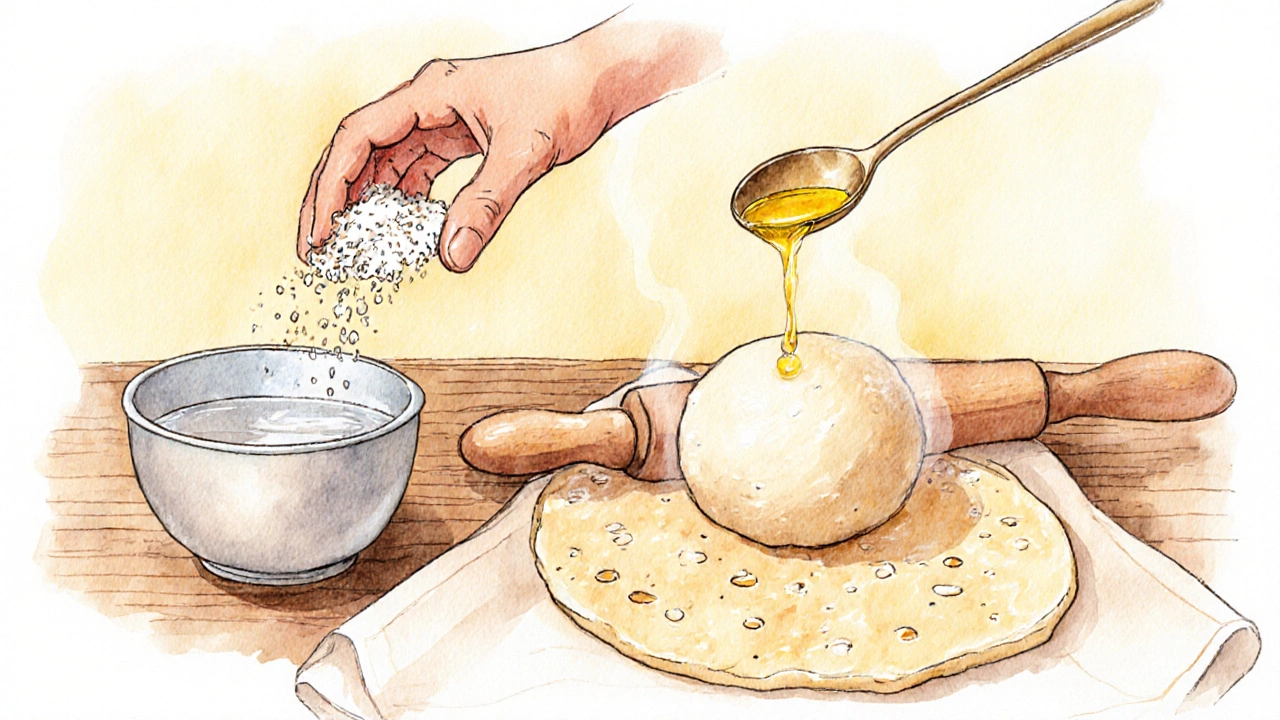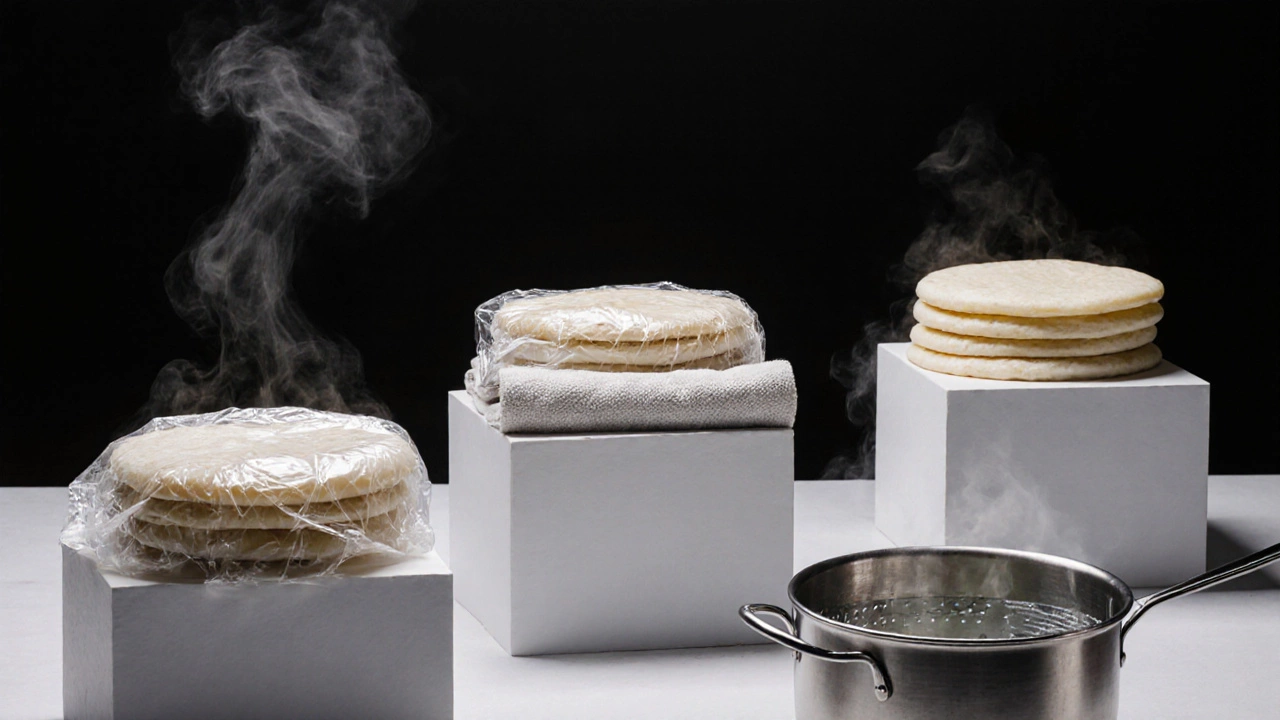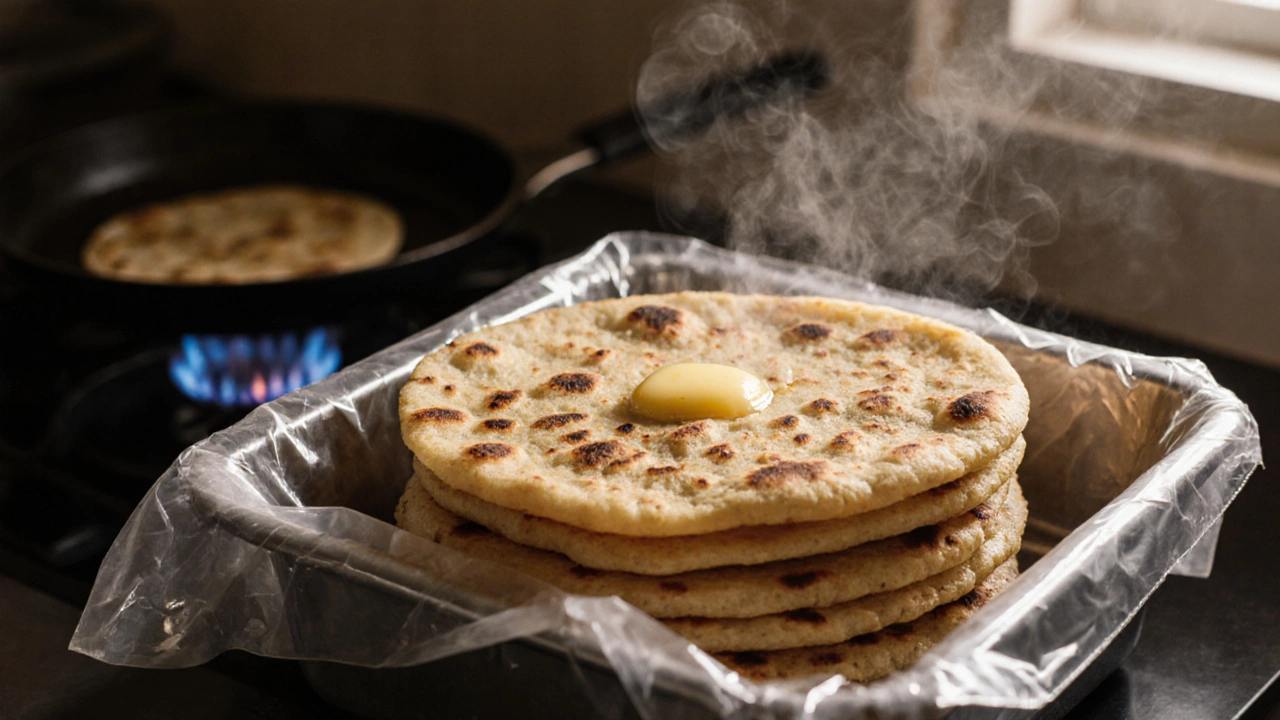Roti Softness Storage Calculator
Discover how long your roti will stay soft based on your storage method. Select the technique you're using to keep your roti fresh and see how long it will maintain its texture.
Storage Method Options
Plastic Wrap (Airtight)
Traps steam completely with an airtight seal. Just roll your hot roti in plastic wrap for the best results.
Aluminum Foil + Cloth
Reflects heat with foil and adds breathability with cloth. Requires two layers for optimal results.
Dry Airtight Container
Easy to use but offers less moisture retention. Best for short-term storage.
Moisture Retention Result
Your roti will stay __ hours soft using this storage method.
Why this method works:
When you think of Roti is a soft, unleavened Indian flatbread made from whole wheat flour, you probably imagine a warm, pillowy disc that stays tender even after a few bites. In reality, many home cooks end up with roti that hardens within minutes, turning a delightful side dish into a chew‑chew nuisance. This guide breaks down exactly how to keep your roti soft for hours, whether you’re serving a family dinner or packing lunch boxes for the week.
What Makes Roti Harden?
Understanding why roti goes stale is the first step to stopping it. Two forces are at play:
- Moisture loss: As the bread cools, water evaporates from the interior, leaving a dry crumb.
- Starch retrogradation: The gelatinized starch in the dough begins to re‑crystallize, turning the soft interior firm.
Both processes speed up in a cool, dry environment. If you can control temperature, humidity, and the way you handle the roti right after cooking, you can dramatically slow down the hardening.
Ingredient Choices that Promote Softness
Even before you light the Tawa is a flat, heavy cooking pan traditionally used for Indian breads, the foundation of a soft roti starts with the dough.
- Whole wheat flour is commonly called "atta" and provides the gluten needed for elasticity. Choose a fresh, finely milled brand; older flour absorbs water unevenly.
- Adding a tablespoon of Ghee is clarified butter that enriches the dough and creates a barrier to moisture loss can make the crumb more tender.
- Warm water (around 40‑45°C) activates the gluten without cooking the flour, giving the dough a smoother texture.
- A pinch of salt not only adds flavor but also helps tighten the gluten network, preventing large air pockets that dry out quickly.
Tip: If you have access to a small amount of milk powder, mixing it in at a 1% ratio (by flour weight) adds extra proteins that keep the interior softer.
Step‑by‑Step Dough Preparation for Long‑Lasting Softness
- Measure 2 cups of whole wheat flour into a bowl.
- Add 1/2 tsp salt and, if desired, 1 tbsp milk powder.
- Create a well in the center and pour in 1 tbsp melted ghee.
- Gradually add 3/4 cup warm water while mixing with your hand. The dough should feel tacky but not sticky.
- Knead for 6‑8 minutes until the surface is smooth and elastic. This develops gluten, the key to softness.
- Cover the dough with a damp kitchen towel (Kitchen cloth is a clean, breathable cotton towel used for food covering) and let it rest for at least 30 minutes. Resting relaxes the gluten and allows water to hydrate fully.
Never skip the resting stage; a rested dough rolls thinner and cooks more evenly, both of which help lock in moisture.

Cooking Technique that Locks in Moisture
When the dough is ready, the way you cook each disc matters as much as the dough itself.
- Heat the tawa on medium‑high until a few drops of water sizzle and evaporate within 10-15 seconds.
- Divide the rested dough into golf‑ball‑size balls and flatten them gently with a rolling pin. Aim for a diameter of 6‑7 inches; a thinner roti cooks faster and retains less moisture, but too thin becomes brittle.
- Place the roti on the hot tawa. Cook for 10-12 seconds until you see bubbles forming.
- Flip and cook the other side for another 10 seconds.
- Press gently with a clean cloth or spatula; the roti should puff up. This puff creates pockets of steam inside, which is the secret to a soft crumb.
- After the roti is golden with a few brown spots, brush each side lightly with melted ghee. The fat layer slows evaporation.
- Immediately stack the hot roti in a steel container or a clean basket and cover with a Plastic wrap is a thin, airtight film that traps steam. If you prefer a biodegradable option, a double layer of foil (Aluminum foil is a shiny metal sheet that reflects heat and prevents moisture loss) works just as well.
By sealing the steam in right after cooking, you create a micro‑environment that keeps the roti soft for hours.
Best Storage Methods for Keeping Roti Soft
Even the perfect cooking technique can be undone if you store roti incorrectly. Below is a quick‑reference table that compares three popular methods.
| Method | Moisture Retention | Convenience | Ideal Duration |
|---|---|---|---|
| Plastic wrap (airtight) | High - traps steam completely | Very easy - just roll | Up to 8 hours at room temperature |
| Aluminum foil + cloth | Medium - reflects heat, cloth adds breathability | Moderate - need two layers | 6-7 hours at room temperature |
| Dry airtight container | Low - no steam, can dry out | Easy - just pop in | 3-4 hours, then re‑steam |
If you’re planning to eat the roti later in the day, the plastic‑wrap method is the safest bet. For a more eco‑friendly approach, wrap in foil and then place a clean kitchen cloth over the top before sealing the container.
Reheating Tricks to Bring Back That Softness
When you pull the roti out of storage, a quick reheating step can revive any lost tenderness.
- **Steam‑burst method**: Fill a wide pan with a inch of water, bring to a gentle boil, and place a metal colander over it. Put the roti inside the colander, cover with a lid, and steam for 30‑45 seconds. The Steam is water vapor that re‑hydrates the bread fibers instantly makes it plush again.
- **Microwave + damp paper towel**: Wrap a roti in a damp (not soggy) paper towel, microwave on high for 15‑20 seconds. The moisture from the towel penetrates the roti, giving a soft bite.
- **Direct griddle heat**: Heat the tawa for a few seconds, place the roti on it, and press gently with a cloth. This adds a fresh crust while the inside stays soft.
Choose the method that fits your time crunch. The steam‑burst is the most reliable for large batches.

Common Mistakes and How to Fix Them
- Too much flour during rolling: It creates a dry exterior. Keep the rolling surface lightly dusted and use a small amount of flour on the rolling pin only.
- Cold water in the dough: The dough becomes stiff and holds less moisture. Always use warm water.
- Cooking on low heat: The roti dries out before the interior puffs. Medium‑high heat is essential.
- Skipping the ghee brush: Without fat, moisture evaporates faster. A thin layer of ghee or oil locks in steam.
- Leaving roti in the open air: Even a few minutes of exposure dries the surface. Stack and cover immediately.
Quick Checklist for Soft‑All‑Day Roti
- Use fresh, fine whole wheat flour (atta).
- Add 1 tbsp melted ghee to the dough.
- Warm water (40‑45°C) for hydration.
- Knead 6‑8 minutes; rest 30 minutes covered.
- Cook on hot tawa until bubbles appear, then flip.
- Brush both sides with ghee right after cooking.
- Stack hot roti, cover with plastic wrap or foil + kitchen cloth.
- Reheat with steam or damp towel if needed.
Frequently Asked Questions
Can I keep roti soft for a whole day?
Yes. If you follow the cooking, ghee‑brushing, and airtight‑wrap method, roti stays pleasantly soft for up to 12 hours at room temperature. For longer storage, refrigerate in a sealed container and re‑steam before serving.
Should I add milk or yogurt to the dough?
A small amount of yogurt (1‑2 tbsp) can add acidity that softens gluten, giving a fluffier texture. Milk powder, as mentioned earlier, also helps, but avoid too much liquid or the dough will become sticky.
Is it okay to freeze roti?
Absolutely. Freeze roti in a zip‑lock bag after wrapping each piece in foil or plastic. When you need them, thaw at room temperature and give them a quick steam‑burst. They’ll be almost as soft as fresh.
Why does my roti get hard even though I cover it?
If the covering isn’t truly airtight, steam escapes and the roti dries. Also, if the roti is too thick, the interior can over‑cook and lose moisture faster. Use a tight‑sealing plastic wrap and keep the roti thin (6‑7 inches).
Can I use a non‑stick pan instead of a tawa?
A non‑stick skillet works, but it often doesn’t get hot enough to create the characteristic puff. A cast‑iron tawa or heavy steel griddle provides uniform high heat, which is key for soft, puffed roti.
